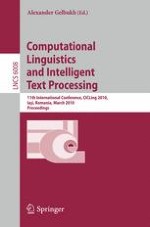th CICLing 2010 was the 11 Annual Conference on Intelligent Text Processing and Computational Linguistics. The CICLing conferences provide a wide-scope forum for discussion of the art and craft of natural language processing research as well as the best practices in its applications. This volume contains three invited papers and the regular papers accepted for oral presentation at the conference. The papers accepted for poster pres- tation were published in a special issue of another journal (see information on thewebsite).Since 2001,theproceedingsofCICLingconferenceshavebeen p- lished in Springer’s Lecture Notes in Computer Science series, as volumes 2004, 2276, 2588, 2945, 3406, 3878, 4394, 4919, and 5449. The volume is structured into 12 sections: – Lexical Resources – Syntax and Parsing – Word Sense Disambiguation and Named Entity Recognition – Semantics and Dialog – Humor and Emotions – Machine Translation and Multilingualism – Information Extraction – Information Retrieval – Text Categorization and Classi?cation – Plagiarism Detection – Text Summarization – Speech Generation The 2010 event received a record high number of submissions in the - year history of the CICLing series. A total of 271 papers by 565 authors from 47 countriesweresubmittedforevaluationbytheInternationalProgramCommittee (see Tables 1 and 2). This volume contains revised versions of 61 papers, by 152 authors, selected for oral presentation; the acceptance rate was 23%.
